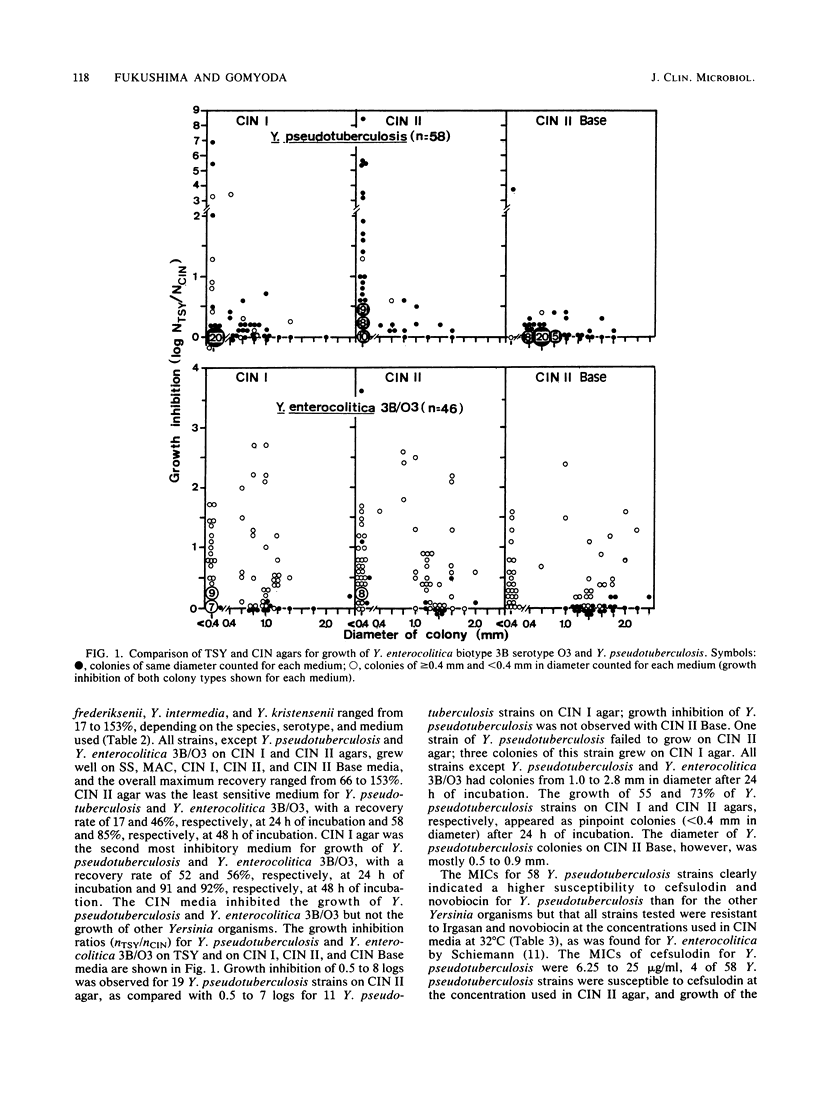Abstract
A total of 169 strains of Yersinia spp. were analyzed for their ability to grow on two different kinds of cefsulodin-Irgasan-novobiocin (CIN) agar containing 15 or 4 micrograms of cefsulodin per ml, on salmonella-shigella agar, and on MacConkey agar. CIN media inhibited the growth of Yersinia pseudotuberculosis and Yersinia enterocolitica biotype 3B serotype O3 (3B/O3) but not the growth of the other Yersinia organisms used. Relative to growth on Trypticase soy agar (BBL Microbiology Systems, Cockeysville, Md.) with 6% yeast extract, 48 and 44% of Y. pseudotuberculosis and Y. enterocolitica 3B/O3 strains, respectively, were inhibited on CIN I agar (low cefsulodin concentration), and 83 and 54%, respectively, were inhibited on CIN II agar (high cefsulodin concentration) after incubation for 24 h at 32 degrees C. The inhibition of Y. pseudotuberculosis growth was significantly more extensive on CIN II agar than on CIN I agar. The MICs of cefsulodin and novobiocin clearly indicated a higher susceptibility for Y. pseudotuberculosis than for the other Yersinia organisms at 32 degrees C. All Y. pseudotuberculosis strains were susceptible to cefsulodin at 15 micrograms/ml (the approximate concentration used in CIN II agar). Y. enterocolitica 3B/O3 strains were resistant to cefsulodin, Irgasan, and novobiocin at the concentrations used in CIN media. These findings show that cefsulodin inhibits the growth of Y. pseudotuberculosis at the concentration used in CIN media and that growth inhibition of Y. enterocolitica 3B/O3 is related to a component of the CIN Base.
Full text
PDF




Selected References
These references are in PubMed. This may not be the complete list of references from this article.
- Davey G. M., Bruce J., Drysdale E. M. Isolation of Yersinia enterocolitica and related species from the faeces of cows. J Appl Bacteriol. 1983 Dec;55(3):439–443. doi: 10.1111/j.1365-2672.1983.tb01683.x. [DOI] [PubMed] [Google Scholar]
- Fukushima H., Nakamura R., Ito Y., Saito K., Tsubokura M., Otsuki K. Ecological studies of Yersinia enterocolitica. I. Dissemination of Y. enterocolitica in pigs. Vet Microbiol. 1983 Oct;8(5):469–483. doi: 10.1016/0378-1135(83)90041-x. [DOI] [PubMed] [Google Scholar]
- Fukushima H., Tsubokura M., Otsuki K., Kawaoka Y., Nishio R., Moriki S., Nishino Y., Mototsune H., Karino K. Epidemiological study of Yersinia enterocolitica and Yersinia pseudotuberculosis infections in Shimane Prefecture, Japan. Zentralbl Bakteriol Mikrobiol Hyg B. 1985 May;180(5-6):515–527. [PubMed] [Google Scholar]
- Head C. B., Whitty D. A., Ratnam S. Comparative study of selective media for recovery of Yersinia enterocolitica. J Clin Microbiol. 1982 Oct;16(4):615–621. doi: 10.1128/jcm.16.4.615-621.1982. [DOI] [PMC free article] [PubMed] [Google Scholar]
- Nesbakken T. Comparison of sampling and isolation procedures for recovery of Yersinia enterocolitica serotype O:3 from the oral cavity of slaughter pigs. Acta Vet Scand. 1985;26(1):127–135. doi: 10.1186/BF03546570. [DOI] [PMC free article] [PubMed] [Google Scholar]
- Schiemann D. A. Development of a two-step enrichment procedure for recovery of Yersinia enterocolitica from food. Appl Environ Microbiol. 1982 Jan;43(1):14–27. doi: 10.1128/aem.43.1.14-27.1982. [DOI] [PMC free article] [PubMed] [Google Scholar]
- Schiemann D. A., Fleming C. A. Yersinia enterocolitica isolated from throats of swine in eastern and western Canada. Can J Microbiol. 1981 Dec;27(12):1326–1333. doi: 10.1139/m81-203. [DOI] [PubMed] [Google Scholar]
- Schiemann D. A. Synthesis of a selective agar medium for Yersinia enterocolitica. Can J Microbiol. 1979 Nov;25(11):1298–1304. doi: 10.1139/m79-205. [DOI] [PubMed] [Google Scholar]
- Schiemann D. A. Yersinia enterocolitica: observations on some growth characteristics and response to selective agents. Can J Microbiol. 1980 Oct;26(10):1232–1240. doi: 10.1139/m80-205. [DOI] [PubMed] [Google Scholar]
- Schindler P. R. Nachweis von Yersinia enterocolitica aus Trinkwasserversorgungsanlagen in Südbayern. Zentralbl Bakteriol Mikrobiol Hyg B. 1984 Dec;180(1):76–84. [PubMed] [Google Scholar]
- Tsubokura M., Inoue M., Nakashima H., Otsuki K., Kawaoka Y. Incidence of Yersinia organism in hare in the northwestern region of Okayama Prefecture. Microbiol Immunol. 1984;28(12):1385–1387. doi: 10.1111/j.1348-0421.1984.tb00796.x. [DOI] [PubMed] [Google Scholar]
- Weber A., Lembke C., Schäfer R. Vergleichende Anwendung von zwei im Handel erhältlichen Selektivnährböden zur Isolierung von :ersinia enterocolitica aus Tonsillen von Schlachtschweinen. Zentralbl Veterinarmed B. 1983 Aug;30(7):532–536. [PubMed] [Google Scholar]


